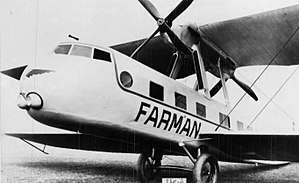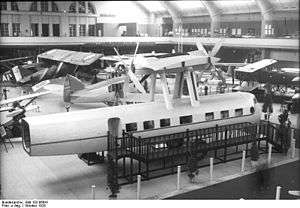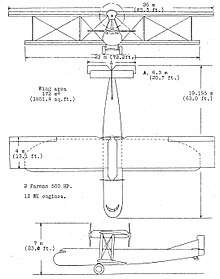Farman F.180
| F.180 Oiseau Bleu | |
|---|---|
 | |
| Role | Biplane airliner |
| National origin | France |
| Manufacturer | Farman |
| First flight | November 1927 |
| Introduction | 1928 |
| Primary user | Farman Line |
| Number built | 3 |
The Farman F.180 Oiseau Bleu (en: Bluebird) was a 1920s French biplane airliner. The F.180 was designed to fly non-stop between Paris and New York, but when the crossing attempt was cancelled three aircraft were built as luxury transports to operate from Paris to nearby European capital cities for the company's own airline.
Development

The F.180 had an advanced (for the 1920s) oval-section fuselage with unequal-span, two-bay wings. It had an enclosed cockpit for two crew and a luxury main cabin for 24 passengers. The aircraft was powered by two Farman piston engines mounted in push-pull configuration in tandem beneath the upper wing centre section, which was supported above the fuselage on two pairs of struts. One design flaw was the landing gear which had a very narrow track main gear wheels which for a heavy aircraft produced a rough ride on grass airfields.
The F.180 flew for the first time in November 1927.[1] The first aircraft was delivered in 1928 followed shortly by two others which all remained in service for a number of years.
Operators
- Farman Line
Specifications (F.180)

Data from [2]
General characteristics
- Crew: 2 (pilot, co-pilot)
- Capacity: 24 passengers
- Length: 18 m (59 ft 0½ in)
- Wingspan: 26 m (85 ft 3½ in)
- Height: 5.80 m (19 ft 0¼ in)
- Wing area: 172 m2 (1851.45 ft2)
- Empty weight: 4500 kg (9921 lb)
- Gross weight: 8000 kg (17,637 lb)
- Powerplant: 2 × Farman 12 We W-12 water-cooled piston engines, 373 kW (500 hp) each
Performance
- Maximum speed: 190 km/h (118 mph)
- Range: 1000 km (621 miles)
- Service ceiling: 4000 m (13,125 ft)
References
| Wikimedia Commons has media related to Farman F.180. |
- Notes
- ↑ Air Museum Aeroquiz: Quiz No. 28 – answers
- ↑ Orbis 1985, p. 1754
- Bibliography
- The Illustrated Encyclopedia of Aircraft (Part Work 1982-1985). Orbis Publishing. 1985.